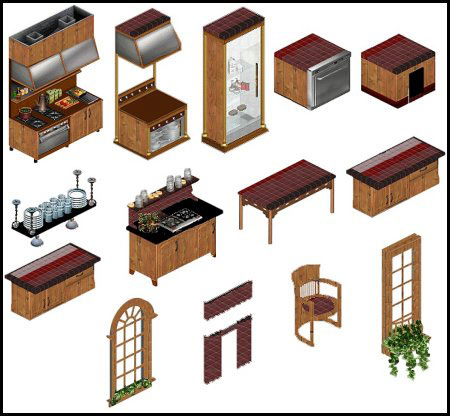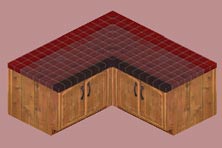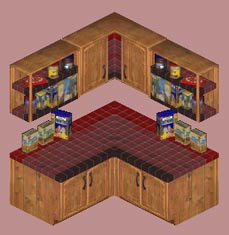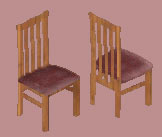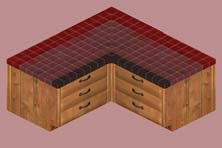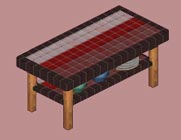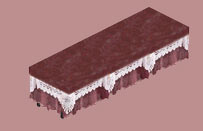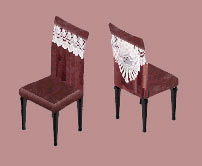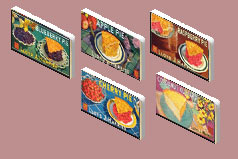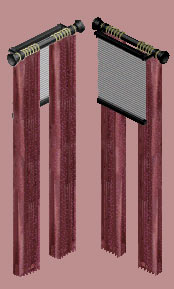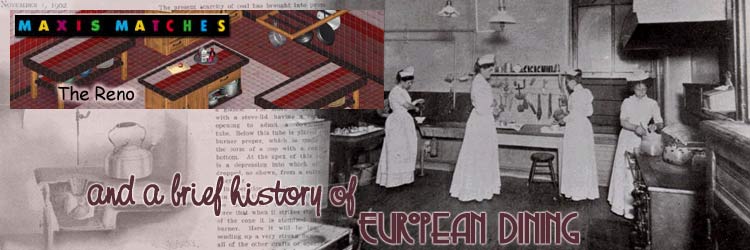 |
| I
am extremely privileged to bring you a brief history of European
dining courtesy of Eras of Elegance - a wonderful reference site
for all things vintage. My grateful thanks go out to them for allowing
me permission to reproduce excerpts from "A BRIEF HISTORY OF
COOKING AND DINING" and I hope you will enjoy this, and also
have a great time exploring their site as much as I do. |
 |
The
last part of the section on Edwardian dining and the modern day sections
are from my own research and have no connection with Eras of Elegance.
The earliest section is annotated with footnotes with grateful thanks
to CharlieChomper for the additional information.
|
|
It doesn't take long
in playing The Sims before one realises that there are very few default
build mode items which match the excellent Maxis default exterior brick
walls - and, puzzling in itself, very few default floors. In the series
"Maxis Matches", you will find several building items retextured
from some of the Maxis wall textures to bring a little harmony into your
homes. Not all of these items will be found in build mode; some will be
found in buy mode / decorative, but all are architectural in style.
|
|
There
is no house with this theme! Download everything in one big zip - find
this at the bottom of the page! Zips
with the normal winzip symbol are just the same objects in smaller packs
below for those with slower connections. If you download the
big zip, you will NOT need any of the smaller zips from below unless they
are marked with the NEW! symbol. Note that showcased items are NOT included
:)
|
 |
|
Well, try as
I may, try as I might, even I couldn't bring myself to find many
build mode items I thought suitable to match this particular wall
from one of the later expansion packs, but I liked the combination
of colours too much to leave it alone. So I have cloned, combined,
reshaped and recoloured some kitchen & dining furniture from
Secret Sims and Simzalabim to match. Some of the taller counters
are smaller at the back so they don't interfere with gameplay. Most
of the counters are cloned on the Rave counter base. All items except
the stove and the floors are priced at
§400
so you can find them easily - although I priced the stove at §4,500,
some pictures at §40
and the walls & floors at §1.
PLEASE NOTE:
Items from Secret Sims are no longer cloneable, and while these
objects were made before they rescinded their decision, they cannot
now be recloned.
|
|
|
|
|
Historians
theorise that the earliest prehistoric peoples trapped and ate insects,
snails, molluscs and other sea creatures, lizards and birds. Early
records also make mention of onions, olives and pomegranates. Onions,
radishes and garlic were the mainstay of the diet of Egyptian slaves
in around 4000 BC, while olives have been cultivated in the Mediterranean
for about 5,000 years, making them one of the oldest fruits.
During
the period between 3000 BC and 1000 BC, the Romans discovered the
process of fermentation and began making rudimentary wine and beer.
In Egypt, this discovery also led to the making of leavened bread.
The subsequent agricultural revolution led to a greater amount of
grain in the general diet, and had an effect on world geography
as more people began living in settlements & farming crops,
though in some areas the settlers clashed with the more aggressive,
meat-eating nomads. As food preservation became more necessary as
settlements grew larger, forms of salting and drying, as well as
the use of snow and ice, were developed.
During
the Mediæval era, dinners were served in courses. Usually,
the first course included soups, fruits and vegetables such as lettuce
and cabbage. Herbs and spices were used in the first course, as
they were believed to be good for digestion, then came dishes of
beef, pork, fish, cheese and nuts & finally, desserts of fruits,
cakes and sweet liqueurs were served. Feasts or large dinners usually
included more courses and varied foods. Royal Mediæval feasts
also included lavish "solteties," which were fanciful
representations of saints, heroes and warriors, made from sugar
and presented in a dramatic display. Pasta, the Italian word for
"dough," was introduced to Italy by Germanic tribes, who
invaded throughout the 5th century. Our word for "noodle"
is derived from the German word for pasta, "nudel." Venetian
traveller Marco Polo was believed to have brought pasta, as we know
it, back from China in 1295. However, macaroni is mentioned in writings
from as early as 1200 so it is probable that pasta in fact dates
back earlier than the thirteenth century.
*Footnote:
While we say above that the Romans had discovered the fermentation
process, the Egyptians had actually began making their own beer
long before even the arrival of the Greeks, who pre-date the Romans
by quite a bit, However, Egyptian beer wasn't really beer as we
now know it, in that it was described to be so thick, a person could
almost chew upon it! Even into Roman times, Egyptian beer was said
to be this way). Likewise,
with regards to wine, it has been around so long that even now,
no one is entirely sure just how long it's been around. There's
currently an archaeologist/wine expert who is trying to locate the
exact origins of wine production and even the grapes used in making
wine.
|
|
|
|
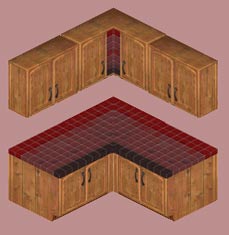 |

| Selection
of six counters. All are the same height and tile together.
Some have a different view for the corner piece to give a bit
of variety. |
|
|
|
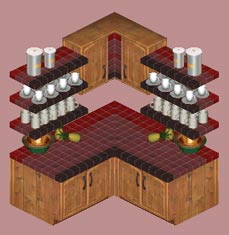 |
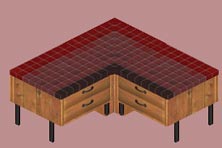 |
| If
you have my original Reno set, you should delete them and replace
with this newer set. The graphics are much improved - but more
importantly..... |
|
|
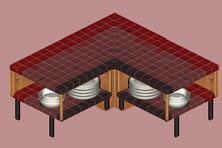 |
|
.....the Z buffers are fixed and none of the counters bleed
anymore! Sing hurrah and shout for joy! Or just download and
use them in your game. |
|
| |
|
|
|
|
In
the Renaissance, many foods were introduced in Europe from newly-discovered
lands in the West, including corn, potatoes, chocolate, peanuts,
vanilla, tomatoes, pineapples, beans, chili peppers and turkey.
Meals for the lower social classes usually consisted of dark bread
such as rye or barley, and cheese or curds. Servants living in wealthy
households usually dined better, enjoying meals of beef or fowl,
refined breads, pudding, cod and ale. They also had access to certain
seasonings such as salt. The middle class enjoyed more variety,
as each meal generally consisted of several different dishes, with
a game bird of some kind being the standard main course. For dessert,
the middle class dined on sweets and confections with spiced wine.
Meals for the wealthiest classes were similar to those of the middle
class, although the rich also enjoyed unusual delicacies such as
elaborately moulded jelly and pastries.
During
Elizabethan times, people generally ate two meals during the day:
"dinner" at noon and "supper" around 6:00 in
the evening. At a feast, guests usually sat on benches, with chairs
reserved for the only most honored guests. Commoners used wooden
bowls and spoons at their meals, and also ate from carving knives
or with their bare fingers rather than forks. Meat was in short
supply in most households and was often cooked with vegetables or
fruits in a stew to make it go further. Salt was a rare commodity
and its use shaped social convention of the day. The salt was placed
in an ornamental "cellar" or "vat" about the
centre of the table, and the places above were assigned to the guests
of distinction, and those who were seated "below the salt"
were dependents, poor relations and those of general lesser rank
- or even sometimes just temporarily out of favour. The lower and
middle classes generally ate grains and vegetables, while the nobility
enjoyed eating meats and sweets. In general, Elizabethan cooking
was generally sweeter than cooking today, although sugar was an
expensive luxury. Meats were often cooked with fruits for flavouring.
Desserts were commonly flavored with almond, as vanilla and chocolate
were rare.
|
|
|
|
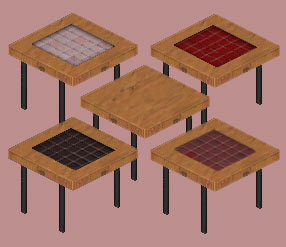 |
| This
set consists of one antique pine table and four antique
pine tables with Reno tiled inlays for modern or informal
dining. Use singly or tile together in patterns to make
your own individual style. |
|
|
|
 Dining tables, dining chair.
Dining tables, dining chair.
Five one-tiled
dining tables to mix'n'match to make your own design or shape.
These all tile together seamlessly, but because they are slightly
wider than one tile, they should not be put in a corner or
against a wall.
|
|
|
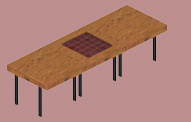 |
|
|
|
|
|
In
the Baroque era, English cuisine consisted of various breads, meat
pies, fresh fruit, sweets and desserts. Many residents of London
ate four square meals a day. Forks were introduced from Italy as
utensils for eating meat. In Europe, the pleasures of a formal dinner
reached new gastronomic heights with the discovery of different
and exotic foods and spices, and the creation of new recipes in
which to use them. In Europe, the pleasures of a formal dinner reached
new gastronomic heights with the discovery of different and exotic
foods and spices, and the creation of new recipes. Visually the
table became more exciting and elaborate with new serving dishes
such as tureens, sauceboats, and centrepieces to present the new
recipes. New porcelain factories competed with silver and goldsmiths
to supply large and elaborate dinner and dessert services to the
courts of Europe, and a growing number of glass factories flourished
as wine glasses found their way onto the table. In this century,
for the first time the dining room became a clearly defined space
within a house dedicated to one particular purpose - the service
and enjoyment of food and all the pomp and circumstance that can
surround it.
Louis
XIV's Court at Versailles established the formal customs of dining
throughout 18th century Europe via "le service à la
française" (the French method of serving), which became
universally accepted as the only civilized fashion of dining. In
the French manner, at each course all the different dishes were
placed on the table at the same time and in exactly prescribed locations.
The diners would help themselves to whatever was near at hand without
moving the dishes, and if necessary pass their plates to their neighbours
to get food that was out of their reach. At large dinners this meant
that it was impractical for guests to sample all the dishes, so
it was important to have an interesting selection of foods near
each guest, and because hierarchy was even more stratified than
in Elizabethan times, those out of favour were seated near a poor
selection of food.
|
|
| |
|
|
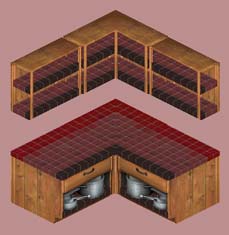 |

| Six more
counters. All are the same height and tile together. Some have
a different view for the corner piece to give a bit of variety.
|
|
|
|
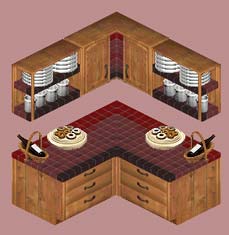 |
|
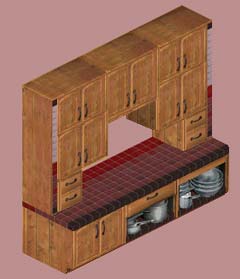 |
The three cabinets
on the left are slightly wider than one tile, so please don't put
them in corners because they will bleed.
The two end
pieces are designed to go either side of the large stove as in the
picture on the right, and I have given you a centre piece for maximum
flexibility in planning your kitchen design.
|
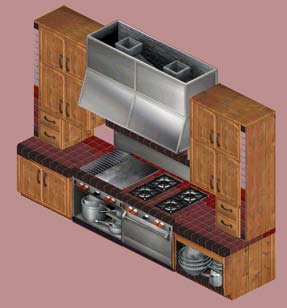 |
|
|
|
|
Prior
to the late 18th century, all meals were cooked on open fires or
in special bakehouses. During the Georgian era, closed ovens became
common in kitchens throughout Europe. Because the thermostat was
not yet widely available or reliable, cooks and bakers relied on
their instincts and experience to determine where and for how long
to place food in ovens. Recipes of the period were still more concerned
with listing the ingredients than giving heating instructions or
exact measurements.
Dinner,
until the later part of the 18th century, was served at midday.
However, as the number of upper-class people increased and became
more bound by social convention, dinner hours were later. Later
dinner hours set the upper-class members of society apart from the
lower classes as they tended to prepare dinner during the day because
it was cheaper to cook, serve and eat the main meal of the day in
natural light. Consequently, to avoid being associated with the
lower classes of society, upper-class members would eat in the evening.
Strict
customs of dining abounded during this period. There were cultural
rules that dictated everything from dressing for the meal to leaving
the dining room. Upper-class women could spend over an hour dressing
for dinner because it was customary for women to change their entire
outfit for the evening meal. The elaborate dinner dress consisted
of a corset, a bodice, stockings, a petticoat, a gown, ruffles and
shoes. After preparing for dinner, guests would proceed into the
dining room. In an elaborate ritual, the host of the dinner would
enter first with the most senior lady. The host would seat himself
at the foot of the table and, later, when the hostess entered the
room as part of the procession, she sat at the head. The senior
lady was first to choose her seat. After the senior lady was seated,
the remaining guests were free to choose their places at the table.
Most likely, the senior lady would sit near the hostess because
the seats near the hostess were places of honour and reserved for
the most important guests.
|
|
|
|
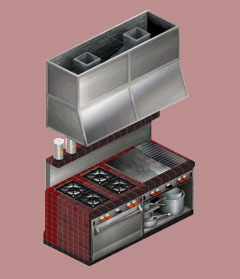 |
 |
Appliances.
|
| Dishwasher,
trash compactor, fridge and large stove all tiled in the Reno
colourways. |
|
When
planning a new kitchen consider ergonomics. Ensure that the
refridgerator, sink and hob are fairly close together and
not separated by a door or passageway. For comfort in use,
place heavy items such as casserole dishes and small appliances
in base cupboards. Lighter items such as glassware or packets
can be stored in wall cupboards. Deep pan drawers with non-slip
bases allow crockery to be stored without sliding as the drawer
is opened and closed. Wall cupboards should be positioned
so that they can be reached easily without undue stretching.
|
|
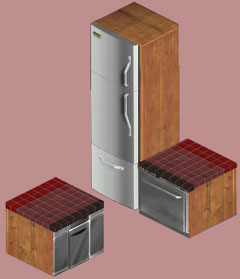 |
|
|
|
|
Every
meal of this period consisted of two courses and a dessert. However,
a single course in eighteenth-century upper-class society consisted
of between five and twenty-five dishes! In one course, soup or creams,
main dishes, side dishes and pastries would be placed on the table
all at once. Unfortunately, this type of presentation meant that
by the time the guests finished eating the soup, the other foods
had to be eaten cold. The dishes were placed on the table with a
certain balance. In the center of the table meat dishes were placed,
while accompaniments were placed on the sides and corners. On one
end, the soup was placed and on the other, the fish would be placed.
Vegetable, fish or custard dishes were never placed at the center
of the dinner table. Dinner was so elaborate that it customarily
took approximately two hours to complete.
During
the Regency era, most middle and upper-class families had their
servants prepare and cook all meals. For example, Mrs. Bennet in
Jane Austen's "Pride and Prejudice" took great pride that
her family was "too genteel for her daughters to be involved
cooking." Modest households, such as those of the clergy, often
were capable of cultivating most of their own produce. Accordingly,
gardening became a valuable skill for women of the period. In England,
fashionable cities such as Bath also offered a wide variety of foods
but often lacked freshness in their produce and milk, due to the
slow transportation and lack of refridgeration of the times.
|
|
|
|
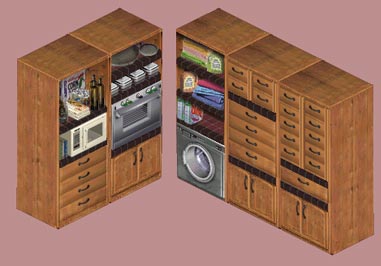 |
| Five cabinets. |
A GUID conflict was found and in August of 2015 files were re cloned with new GUIDs. This zip was effected by that repair.
To complete
your fitted kitchen or pantry, here are five large cabinets,
some with built-in appliances. Please note that the ovens
and washing machine are just for decoration only. These
cabinets are actually bookcases, and will teach your sims
to cook if nothing else.
|
|
|
|
|
|
The
Victorian era was a period of extravagant entertaining for the upper
middle and high classes. Victorian meals consisted of as many as
nine courses, although many dishes were light and petite-sized.
Fine ingredients, such as exotic spices imported from distant countries,
were used in lavishly prepared meals. Culinary schools were established
for the first time in history, while popular recipe books by chefs
such as Agnes B. Marshall and Isabella Beeton became all the rage
in England as detailed measurements and instructions were written
down for the first time.
The
institution of afternoon tea became highly popular during the Victorian
era. Afternoon tea was invented by Anna, Duchess of Bedford (1783-1857),
one of Queen Victoria's ladies-in-waiting. During this time, the
noble classes ate large breakfasts, small lunches and late suppers.
Every afternoon, Anna reportedly experienced what she referred to
as a "sinking feeling," so she requested that her servants
bring her tea and petite-sized cakes to her boudoir. Many followed
the Duchess' lead, and thus the ritual of afternoon tea was birthed.
In fact, a culture of sorts emerged around the tradition of drinking
tea. Fine hotels began to offer tea rooms, while tea shops opened
for the general public. Tea dances also became popular social events
at which Victorian ladies met potential husbands.
|
|
|
|
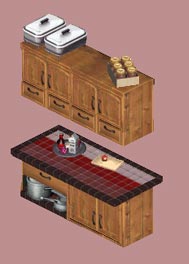 |
| Three kitchen
islands. |
These
islands are actually desks, so your sims can eat their meals
from them.
|
|
|
|
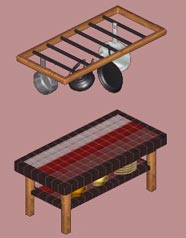 |
|
|
|
|
|
The
Edwardian era saw the beginning of the modern food industry, largely
due to inventions such as the steam tractor, which transformed farming
into a grand-scale operation, refrigeration which enabled foods
to keep fresher longer, and an efficient established distribution
network both at home and world-wide. Self-service grocery stores
and supermarket chains opened for the first time in history. A host
of brand-name foods soon emerged and the advertising industry was
in full swing promoting the values of such products.
As
Prince of Wales, and later as King, Edward VII was a broadminded,
fun-loving man and he mixed, with some freedom, with men and women
of all classes. A privileged few gained access to his personal circle
of friends known as the 'Marlborough Set'. Wealth rather than birth
was a passport to the society he dominated, as the entertainment
the King appreciated was costly. He had a hearty appetite, and huge
breakfasts were followed by a large lunch, tea, dinner and midnight
snack. He enjoyed food of rich flavour and rare quality and seldom
sat down to a dinner consisting of less than twelve courses. Nothing
was too expensive or too difficult to obtain for his table - caviar,
truffles, snipe, partridge, oysters, quail, ptarmigan (white grouse),
pressed beef, ham, tongue, chicken, galantines, lobster, melons,
peaches, nectarines and specially imported jams and biscuits would
be acquired in the hope of pleasing him. A typical society dinner
menu for twenty persons cost approximately £60 - much more
than the annual income of a maid.
His
desires set the tone of extravagance associated with the era. Conspicuous
consumption by the rich was seen as normal and even desirable. That
consumption varied from extensive menus, to newly decorated interiors,
costly travel abroad, and sartorial art at its most complex. Rich
ladies were dressed elaborately and with great variety which was
costly. Society hostesses wore different clothes for every occasion
and the art of dressing was so complex that they could not dress
properly without the help of a ladies maid.
|
|
|
|
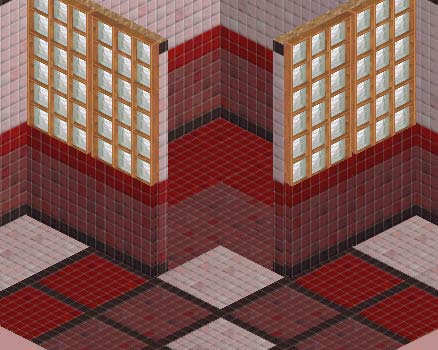 |
 |
|
Six floor
tiles to mix'n'match, and a window room divider.
I use
this to "mask" off areas which are unsightly in
a kitchen, such as the trash compactor, while leaving a gap
in the wall rather than placing a door for unimpaired functionality.
|
|
Flooring in the kitchen should be a mixture of the highly
functional and decorative. Choose non-slip materials and always
wipe up spills immediately. Water-resistant floors will not
warp or crack. Remember that ceramic tiles or slates can be
quite tiring to stand on for long periods as they have no
flex, while vinyl floorings are warm underfoot, and have the
advantage of giving a softer cushioned landing to any items
accidentally dropped.
|
|
|
|
The
food industry of modern times is a very different picture than anyone
from these previous eras could ever have imagined. Being able to
browse through a choice of foods on a scale undreamed of even less
than 50 years ago, buy staple foods at affordable prices and seek
out the exotic at any hour of any day is a tremendous advance. Overall,
choice and quality is better than it has ever been. Networks of
worldwide distribution mean that once-seasonal foods are now freshly
available all the year round and only a short journey away from
most homes. We can eat what we want when we want without mum having
to be at home all day cooking three meals a day. However, there
is a downside to all of this.
Food production has become so mechanised, processed, packaged and
commercialised that surveys of schoolchildren regularly turn up
startling results. One group had no idea that chips (either English
or American style!) were made from potatoes or that potatoes grew
underground. One group had difficulty recognising a bunch of freshly
pulled soil covered carrots or brussels sprouts still on the stem.
Most did not know that vegetables could be grown from seeds.
The
pursuit of plenty has also yielded some far more shameful side effects.
The careless exploitation of countries, cultures and creeds by multinational
concerns, an endless round of health scares, the use of artificial
flavourings colourings and preservatives (the infamous "E Numbers"),
animal welfare outrages, environmental violations and the all-consuming
goal of huge profits at the expense of economic decline or ruin
elsewhere have shocked the public so much so that today’s consumers
are broadly mistrustful of the industry which fills their plates.
This uneasiness among the consuming public is exacerbated by the
fact that shoppers who are suspicious of these developments also
feel powerless to avoid them or to change the situation.
|
|
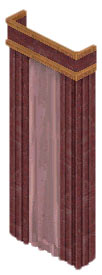 |
Curtain
set of formal pleated damask hung either side of translucent
layers of voile topped with antique wood and damask pelmet.
|
|
This curtain set is based on a wall lamp making it a much smaller
file than Unleashed curtains, and I show it on white so you
can see the transparency better. |
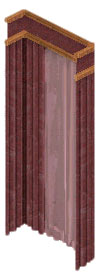 |
|
|

Formal
dining set consisting of table, chair, three carpet floor
tiles, pelmeted curtains
|
|
|
| The chair
has been upholstered with a fine damask seat and matching antimacassar
which protects a cover of fine Chantilly lace securing the plum
coloured voile tightly fitted to the back. |
|
|
|
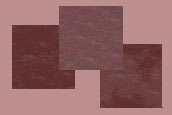 |
| One-tiled
dining table to tile together to make your own design or shape.
It tiles together seamlessly, but because the table is slightly
wider than one tile, it should not be put in a corner or against
a wall. |
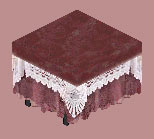 |
| The table
comes with a fine damask fitted tablecloth which protects a
cover of fine Chantilly lace itself resting on top of layers
of translucent plum coloured voile. This table is intended for
more formal dining situations. Again, this table tiles together
seamlessly and the voile is semi-transparent in the game. |
|
|
|
|
|
There
is growing concern about the use of biotechnology and genetic modification
(the joining of pieces of DNA in new combinations to allow characteristics
to be transferred between organisms) to improve varieties of plants
or micro-organisms for use in agriculture and industry. Biotechnology
may someday be considered a safe agricultural tool but present studies
suggest it may have harmful ecological consequences, such as spreading
genetically-engineered genes to indigenous plants, increasing toxicity
which may move through the food chain, disrupting nature's system
of pest control or even creating new weeds or virus strains.
The
widespread use of antibiotic genes as "markers" in genetically
modified crops threaten the already growing problem of antibiotic
resistance, which the world medical community acknowledges as a
serious public health concern. Though food-producing animals are
given antibiotic drugs for important therapeutic, disease prevention
or production reasons, these drugs can cause microbes to become
resistant to drugs used to treat human illness, ultimately making
some human sicknesses harder to treat. Part of the problem is that
bacteria and other microorganisms that cause infections are remarkably
resilient and can develop ways to survive drugs meant to kill or
weaken them. There is more on this topic at The
Centers for Disease Control and Prevention.
The
long term use of pesticides on crops and antibiotics in livestock
are also causing huge concerns about the irreversible damage of
the world's ecosystem, and other closer to home health issues such
as the possible alteration of our fundamental genetic structure.
The long-term effect of disorders such as Creutzfeldt-Jakob Disease
(also known as CJD and is a fatal brain-degenerative disease) which
are believed to originate from exposure to contaminated food are
impossible to predict as the disease is believed to incubate for
at least 10 years.
|
|
|
|
|
|
 |
| A GUID conflict was found and in August of 2015 files were re cloned with new GUIDs. This zip was effected by that repair.
Six
smoke alarms which look like vintage fruit pictures
(below), five reversible pie label pictures (left),
five fruit paintings on new two-tiled painting
bases and more curtains. I apologise for the poor
image quality of the pictures here; they do look
much better in the game.
|
|
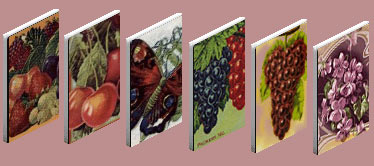 |
| The
curtain consists of two tightly ruched layers of voile
hung either side of a translucent venetian blind. This
curtain set is based on a freestanding lamp making it
a much smaller file than Unleashed curtains - and you
can still put things on the wall or window. |
|
 |
|
These
five fruit paintings come on new two-tiled painting
bases! They are all reversible, meaning you can read
words from both directions and are backless so they
won't obscure your game from the back.
The
largest one is the same size and shape as the LL Roy
Lichtenstein painting and the others are the same width
but different heights. These images are smaller than
the actual paintings.
|
|
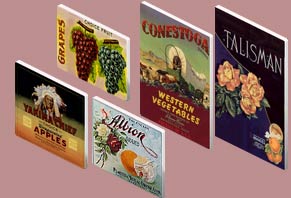 |
|
|
|
|
Due
to aggressive and highly influential advertising, many parents
feel they are targets of blackmail, being constantly under
pressure to buy "junk" foods. In particular, many
feel they are in competition with advertisers who they believe
deliberately target their children using techniques to fan
the flames of "pester power". This
feeling is not without validation or good reason. A recent
scheme in the UK has come under fire despite being marketed
to look beneficial. Children
are being encouraged to save up tokens from bars of chocolate,
which can then be redeemed against sports equipment. Yet to
earn one netball (worth about £5), primary-school children
would have to spend nearly £40 on chocolate and consume
more than 20,000 calories. And a 10-year-old child eating
enough chocolate to earn a basketball would then have to play
the sport for 90 hours to burn off the calories consumed.
Marketing
has become big business, and psychological concepts, psychodynamics
and psychographic profiling are common tools in advertising.
Suspicion about the ramifications of using such methods has
led to many scare stories in the past about unconscious manipulation
by way of "subliminal advertising" - based on the
fact that under any circumstances, you store more information
in a fraction of a second and are influenced by it than you
are ever consciously aware of - such as the story of how an
early experiment at a movie theatre substantially increased
interval sales of popcorn and soft drinks. You can read more
about this at the wonderful Snopes.
However,
subliminal marketing techniques are not all easily disproved.
Manipulative
and embedded feel-good (more often than not sexual) stimuli
in graphics are frequently used in what is now being termed
with heavy irony as "semi-subliminal advertising".
This is a fascinating topic all of its own, and deserves far
more attention than I can give it here, although you can get
some idea of what happens at The
Subliminal World - although the images are very poor and
do not do the subject any real justice. A more balanced article
can be found at Subliminal Perception by Chris Thomas.
|
|
|
|
|
| Three formal
wallpapers for a dining room, all with wood skirting and dado
to match the Reno wood, with textured papers in the Reno colourways.
The pattern on the first two is a traditional style taken &
adapted partly from The Grammar Of Ornament, of which you can
read more on other pages of my site. The third paper features
a colourwash again using the Reno colourways. |
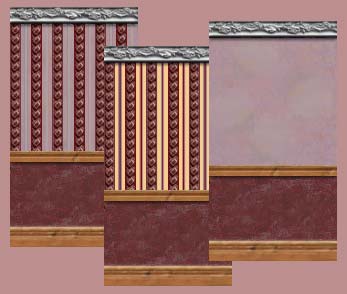 |
|
|
|
|

Formal
Dining Set 2 consisting of three wallpapers, eight formal
prints and two wooden floors.
|
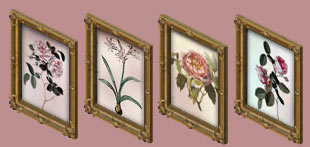 |
A GUID conflict was found and in August of 2015 files were re cloned with new GUIDs. This zip was effected by that repair. Eight reversible
antique floral or fruit prints. I chose these again to match
the Reno colourways. These prints are more formal than the block
prints so I put them in frames for your dining room. All these
prints are one tile. |
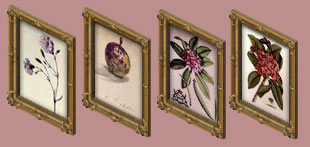 |
|
|
It
is not all doom and gloom in today's food retailing world. There
is a growing trend towards responsible retailing in many supermarkets,
and consumer spending power is at the forefront of helping this
along. Fairly traded goods, cruelty-free meats, non-animal tested
toiletries or household chemical products are all growing alternatives
increasingly available in our stores. The Fairtrade association
is committed to providing fair wages and good employment opportunities
to economically disadvantaged artisans and farmers worldwide. The
RSPCA "Freedom Food" scheme radically improves the welfare
standards for animals at all stages of the food chain. UK regulations
on animal testing are considered some of the most rigorous in the
world - the Animals Act of 1986 insists that no animal experiments
be conducted if there is a realistic alternative, and there are
many companies worldwide offering excellent products where no animal
testing has been done at any stage of development or production.
Detailed labelling information has increasingly led to the exposure
of certain "tricks of the trade" and there are plenty
more to come. We are already aware that excess salt, fat and sugar
are widely used to make products look better than they are, and
water is often used to make products look bigger than they are.
Some packaged bacon often contains so much injected brine that when
it is cooked, it releases as much volume of the viscous white liquid
as there is meat left at the end of the process.
But
how many people know, for instance, that some wine clarifiers are
animal-based products such as egg whites, milk, casein, gelatine
(an animal protein derived from the skin, bones and connective tissue
of pigs and cows) and isinglass (prepared from the bladder of the
sturgeon fish)? Or that bone is used in the decolourisation of sugar?
Vegetarians and other groups with dietary concerns should be able
to find this out at the point of sale, rather than having to research
and find out at a later date. The Co-operative Wholesale Society
in the UK continues its pioneering history with the campaign for
a change in the law which currently prohibits the listing of ingredients
and processing aids on its wines and spirits labels so they can
do just that.
|
|
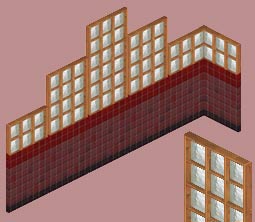 |
| I apologise
for the poor quality of the image above. The glass blocks are
actually quite detailed as you can see from the actual size
at the bottom right. |
|
 |
| A GUID conflict was found and in August of 2015 files were re cloned with new GUIDs. This zip was effected by that repair.
Room divider
kit & three large pictures. The large room divider is
different to the earlier one as it is based on the one tile
mat base by Simfreaks and is not droppable. You can place
other items on the same tile but if they are too large (a
worksurface for instance) they may bleed through.
The pictures
are two-tiled and require LL.
|
|
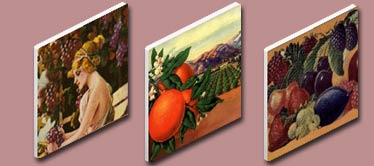
|
|
|
Commerce
with a conscience is becoming big business as around the world,
consumer pressure and media attention have encouraged companies
to address corporate social responsibility. Large corporations
are being called to account for the impact of their practices
on international human rights. As consumers increasingly ask
"How free is the free market?" and "Why in
a world economy do the poor get poorer and the rich get richer?",
conglomerates are being forced to find ethical alternatives.
There is a growing fair trade movement around the world, where
local producers are able to fairly trade their products to
a worldwide audience.
However,
ethical global trading isn't always easy to maintain when
globalization in its current form does not seem to favour
those on either side who want trade to be fair. Trade can
be a powerful engine for poverty reduction and supporting
worldwide economic growth but that potential is being lost
through rigged markets and double standards. For instance,
one statistic shows that rich countries spend $1bn every day
on agricultural subsidies while the resulting surpluses are
dumped on world markets, undermining the livelihoods of millions
of smallholder farmers in poor countries. Not only that, but
when developing countries export to rich-country markets,
they face tariff barriers that are four times higher than
those encountered by rich countries. Those barriers cost them
$100bn a year - twice as much as they receive in aid.
A
lot is being done. But more can - and should - be done to
benefit us ALL.
|
| Further
reading on some of these subjects can be found at: |
|
|
| Please
note that we cannot take any responsibility for the content
of Web pages found at or through links on this page, which are
provided solely for information. These links do not imply an
endorsement of these organizations by myself, woobsha.com,
or any other site linked to here. |
|
|
|
All the
objects above can be downloaded in this one BIGZIP  The BIGZIP is just a normal zip file with all 79 items above inside one
large zip, I just call it that to distinguish it from the normal sized
zips.
The BIGZIP is just a normal zip file with all 79 items above inside one
large zip, I just call it that to distinguish it from the normal sized
zips.
GUID conflicts were found and in August of 2015 files were re cloned with new GUIDs. This zip was effected by that repair.
This one zip contains
everything pictured above that does not have the NEW! symbol next to it.
Unzip to a temporary storage folder, and you must move the files accordingly
as below:
|
- Files ending
in .wll
to C:\Program Files\Maxis\The Sims\GameData\Walls
- Files ending
in .flr
to C:\Program Files\Maxis\The Sims\GameData\Floors
- Files ending
in .iff to C:\Program Files\Maxis\The Sims\GameData\UserObjects
|
|
If you would like
to redesign or recolor objects from the Reno set, please provide credit
on your site and in the object description with a link back to us. Most
recolours here are from base items from sites participating in the Recolourers
Resource Project, but where I have had specific permission for an item
to be cloned for this set, you will need to ask the same permissions from
the original designer - these are as follows:
- Items from Secret
Sims are no longer cloneable.
|
 |
Want
more items in Reno? See the lovely Reno completer set at Sophisticated
Sims |
|
|
|
|
| All links to the original
site where I have made the recolour from are given. See notes on home page.
Historical information Copyright (C) 2000-2004, Eras of Elegance, Inc. All
rights reserved. Reproduction in whole or in part in any form or medium
without express written permission is strictly prohibited. |
|
|
|














 The BIGZIP is just a normal zip file with all 79 items above inside one
large zip, I just call it that to distinguish it from the normal sized
zips.
The BIGZIP is just a normal zip file with all 79 items above inside one
large zip, I just call it that to distinguish it from the normal sized
zips.